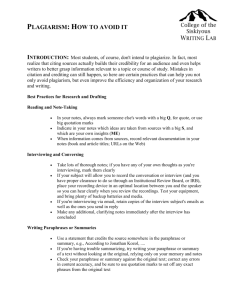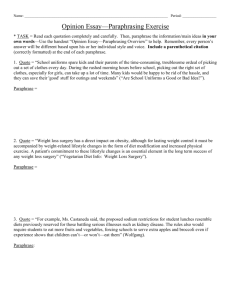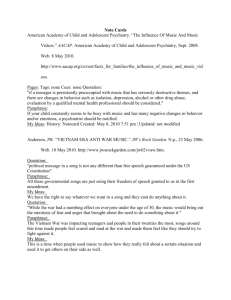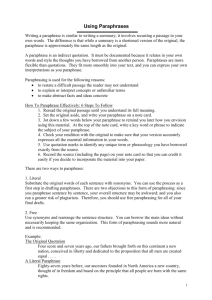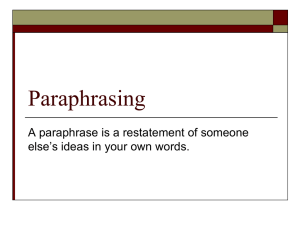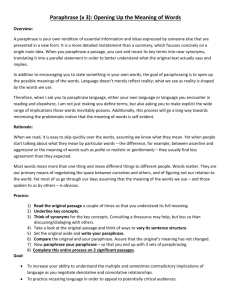Paraphrase and Direct Quotes
advertisement
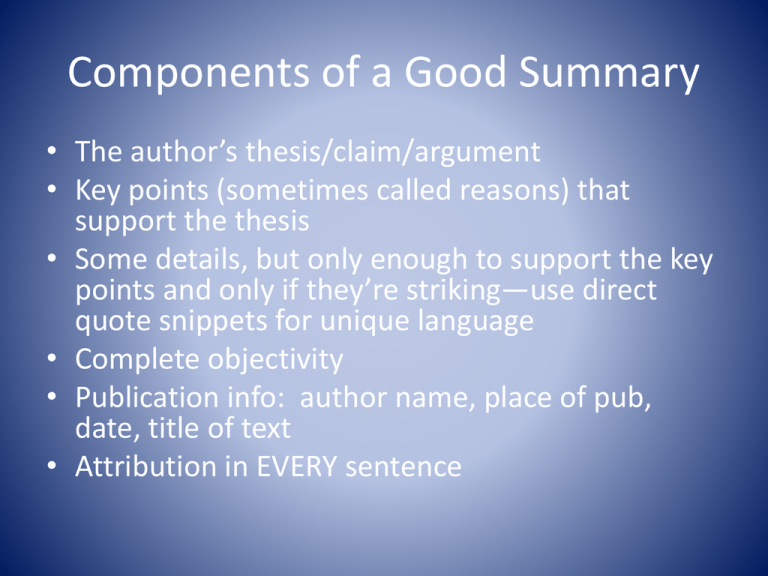
Components of a Good Summary • The author’s thesis/claim/argument • Key points (sometimes called reasons) that support the thesis • Some details, but only enough to support the key points and only if they’re striking—use direct quote snippets for unique language • Complete objectivity • Publication info: author name, place of pub, date, title of text • Attribution in EVERY sentence Summary, Paraphrase, DQ Notes • Summary: convey the essential argument and main/key points of a text, representing the ideas accurately and concisely. • • Relies on description, paraphrase, and direct quotation. Summary, Paraphrase, DQ Notes • Description: describe the main features of text, including: • Author • Title • Context/place of publication • Thesis/main argument • Key points that support thesis • Paraphrase • Paraphrase: restates a passage in different words; retains original meaning without plagiarizing. • Steps for proper paraphrase: • Read original carefully • Substitute words, ask if precise meaning is upheld • Rearrange sentences, asking yourself about precise meanings • Check the meaning of your paraphrase against the original • Identify the source you are paraphrasing/ attribute Paraphrase Example • Original: High school cliques, which reproduce the class divisions found in society, originate from three distinct sources: racial differences, gender differences, and social differences. • • Morgan, Addie. “High School Anxiety.” Time 42.2 (2010): • 42-44. Print. • Paraphrase: Peer groups in high school mirror society’s class distinctions, which stem from differences in race, gender, and social status, according to Addie Morgan. Plagiarism example • Original: High school cliques, which reproduce the class divisions found in society, originate from three distinct sources: racial differences, gender differences, and social differences. • • Morgan, Addie. “High School Anxiety.” Time 42.2 (2010): • 42-44. Print. • Plagiarism: Peer groups in high school reproduce the class divisions found in society and come from three distinct sources: race, gender, and social differences, according to Morgan. Direct Quotation • Direct Quotation: often, summaries directly quote a few key phrases or sentences. Use sparingly to convey key points, unusual/unique language, or tone of original. • Must be accurate • Must have quotation marks around any original language • Don’t quote long sentences…if you want, you can use an ellipsis to indicate words omitted. Example of DQ • Original: Although educational reform in America tends to focus on curriculum issues, class sizes, and security issues, one lesson seems increasingly hard to teach— helping students appreciate and welcome differences in culture, racial heritage, and personal identity. • Condensed Quotation/Paraphrase: Educational reform, according to Morgan, should pay less attention to “curriculum issues” and “class sizes” and more attention toward “helping students appreciate[…] differences in culture, racial heritage, and personal identity.” Group Summaries • In groups, you will collaboratively write an academic summary for one of the articles that uses all of the good strategies we’ve talked about in class. You will need to first compare your summary outlines with the members of your group and discuss what to include. You may also want to discuss why there may be differences in your ideas about the thesis and key points. Once you reach a consensus about what the summary should include, type the information in paragraph form. You will be sharing these with the class.

